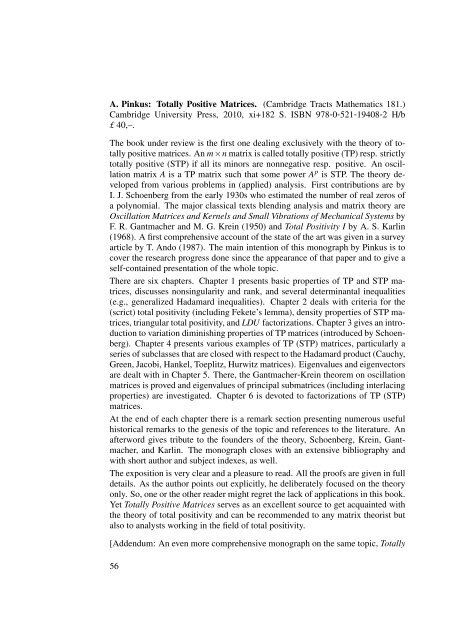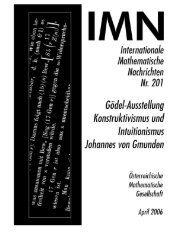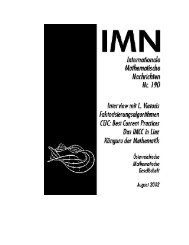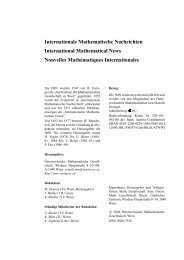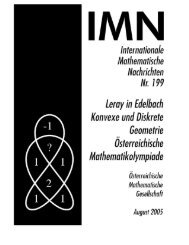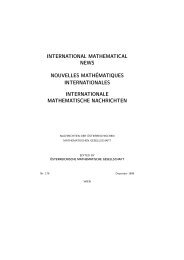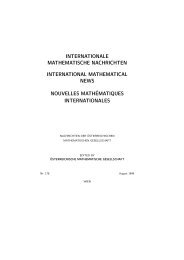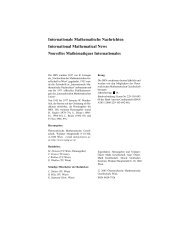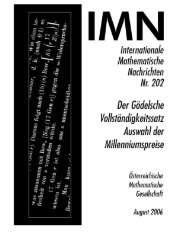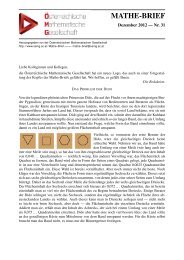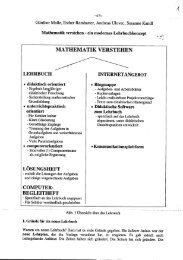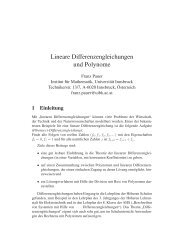218 - Ãsterreichische Mathematische Gesellschaft
218 - Ãsterreichische Mathematische Gesellschaft
218 - Ãsterreichische Mathematische Gesellschaft
Erfolgreiche ePaper selbst erstellen
Machen Sie aus Ihren PDF Publikationen ein blätterbares Flipbook mit unserer einzigartigen Google optimierten e-Paper Software.
A. Pinkus: Totally Positive Matrices. (Cambridge Tracts Mathematics 181.)<br />
Cambridge University Press, 2010, xi+182 S. ISBN 978-0-521-19408-2 H/b<br />
£ 40,–.<br />
The book under review is the first one dealing exclusively with the theory of totally<br />
positive matrices. An m×n matrix is called totally positive (TP) resp. strictly<br />
totally positive (STP) if all its minors are nonnegative resp. positive. An oscillation<br />
matrix A is a TP matrix such that some power A p is STP. The theory developed<br />
from various problems in (applied) analysis. First contributions are by<br />
I. J. Schoenberg from the early 1930s who estimated the number of real zeros of<br />
a polynomial. The major classical texts blending analysis and matrix theory are<br />
Oscillation Matrices and Kernels and Small Vibrations of Mechanical Systems by<br />
F. R. Gantmacher and M. G. Krein (1950) and Total Positivity I by A. S. Karlin<br />
(1968). A first comprehensive account of the state of the art was given in a survey<br />
article by T. Ando (1987). The main intention of this monograph by Pinkus is to<br />
cover the research progress done since the appearance of that paper and to give a<br />
self-contained presentation of the whole topic.<br />
There are six chapters. Chapter 1 presents basic properties of TP and STP matrices,<br />
discusses nonsingularity and rank, and several determinantal inequalities<br />
(e.g., generalized Hadamard inequalities). Chapter 2 deals with criteria for the<br />
(scrict) total positivity (including Fekete’s lemma), density properties of STP matrices,<br />
triangular total positivity, and LDU factorizations. Chapter 3 gives an introduction<br />
to variation diminishing properties of TP matrices (introduced by Schoenberg).<br />
Chapter 4 presents various examples of TP (STP) matrices, particularly a<br />
series of subclasses that are closed with respect to the Hadamard product (Cauchy,<br />
Green, Jacobi, Hankel, Toeplitz, Hurwitz matrices). Eigenvalues and eigenvectors<br />
are dealt with in Chapter 5. There, the Gantmacher-Krein theorem on oscillation<br />
matrices is proved and eigenvalues of principal submatrices (including interlacing<br />
properties) are investigated. Chapter 6 is devoted to factorizations of TP (STP)<br />
matrices.<br />
At the end of each chapter there is a remark section presenting numerous useful<br />
historical remarks to the genesis of the topic and references to the literature. An<br />
afterword gives tribute to the founders of the theory, Schoenberg, Krein, Gantmacher,<br />
and Karlin. The monograph closes with an extensive bibliography and<br />
with short author and subject indexes, as well.<br />
The exposition is very clear and a pleasure to read. All the proofs are given in full<br />
details. As the author points out explicitly, he deliberately focused on the theory<br />
only. So, one or the other reader might regret the lack of applications in this book.<br />
Yet Totally Positive Matrices serves as an excellent source to get acquainted with<br />
the theory of total positivity and can be recommended to any matrix theorist but<br />
also to analysts working in the field of total positivity.<br />
[Addendum: An even more comprehensive monograph on the same topic, Totally<br />
56


